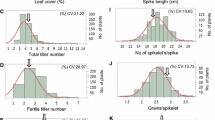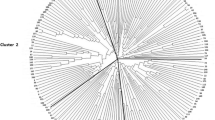Abstract
Emmer (Triticum dicoccon Schrank,2n = 4x = 28) is a hulled wheatspecies [more] widely spread in the Mediterranean basin. In Italy it survives as acrop in a few marginal areas and peculiar ecological niches in different regionsof central and southern Italy. A renewed interest has occurred during the lastdecade toward local varieties belonging to this species. As a matter of fact,local varieties have the highest genetic variation and adaptation to the naturaland anthropological environment from where they originated. Results on thegenetic diversity within and relationships among 11 Italian local varieties ofemmer as assessed with 17 RAPD marker loci are here reported. The proportion ofthe among-local variety genetic diversity was as high as 48% (GST =0.479). Thus, about 52% of the total variation was within population. Localvarieties of emmer proved to be formed by a variable number of lines geneticallydistinguishable from each other, and the vast majority of individuals overpopulations proved to be different multilocus genotypes. Landraces of emmer fromcentral and southern Italy showed distinctive molecular traits. In particular,local varieties classified as «Central Italy» types were characterized by a common set of RAPD marker alleles and proved to bedistinguishable from both the «Southern Italy» and the«Garfagnana» accessions. The overall results confirm the highvariability that can be found within landrace populations, underlining thevalues of landraces as an irreplaceable bank of genetically diversified andhighly co-adapted genotypes. Information for an appropriate insitu conservation and management of this valuable source of emmergermplasm is discussed.
Similar content being viewed by others
References
Barcaccia G. 1994. Development, comparability and potential applications of RAPD markers in the genus Medicago. J. Genet. Breed. 48: 161–168.
Barcaccia G. and Rosellini D. 1996. A quick method for the isolation of plant DNA suitable for RAPD analysis. J. Genet. Breed. 50: 177–180.
Barcaccia G., Albertini E., Torricelli R., Russi L., Tomassini C., Negri V. et al. 1998. Caratterizzazione di antiche varieta locali di lenticchia e farro (with English summary) Atti del IV Congresso Nazionale Biodiversita September 8-11, 1998, Alghero, Italy, pp. 841–844.
Bonnin I., Huguet T., Gherardi M., Prosperi J.M. and Olivieri I. 1996. High level of polymorphism and spatial structure in a selfing plant species, Medicago truncatula (Leguminosae), shown using RAPD markers. Am. J. Bot. 83: 843–855.
Castagna R., Minoia C., Porfiri O. and Rocchetti G. 1996. Nitrogen level and seeding rate effects on the performance of hulled wheats (Triticum monococcum L., T. dicoccum Schubler and T. spelta L.) evaluated in contrasting agronomic environments. J. Agron. and Crop Sci. 176: 173–181.
Cubadda R. and Marconi E. 1996. Technological and nutritional aspects in emmer and spelt. In: Padulosi S., Hammer K. and Heller J. (eds), Hulled wheats. Promoting the conservation and st use of underutilized and neglected crops. Proc. of 1 Intl. Workshop on Hulled Wheats, July, 21-22, 1995. Castelvecchio Pascoli, Lucca, Italy, pp. 203–211.
D'Antuono L.F. and Pavoni A. 1993. Phenology and grain growth of Triticum dicoccum and T. monococcum from Italy. In: Damania A.B. (ed.), Biodiversity and Wheat Improvement. Wiley-Sayce, UK, pp. 273–286.
D'Antuono L.F. and Minelli M. 1998. Yield and yield components analysis of emmer wheat (Triticum dicoccum Schubler) landraces from Italy. In: Jaradat A.A. (ed.), Proc. of the 3rd Intl. Triticeae Symposium, May, 4-8, 1997, Aleppo, Syria. Science Publisher, Inc., USA, pp. 393–404.
Dice L.R. 1945. Measures of the amount of ecological association between species. Ecology 26: 297–302.
Ennos R.A. 1994. Estimating the relative rates of pollen and seed migration among plant populations. Heredity 72: 250–259.
Gower J.C. 1996. Some distance properties of latent root and vector methods used in multivariate analysis. Biometrika 53: 325–338.
Kimura M. and Crow J.F. 1964. The number of alleles that can be maintained in a finite population. Genetics 49: 725–738.
Laghetti G., Piergiovanni A.R., Perrino P. and Blanco A. 1998. Agronomic and nutritional characteristics in emmer and spelt. In: Slinkard A.E. (ed.), Proc. of 9 Int. Wheat Genetic Symposiun, August, 2-7, 1998. University Extension Press, Saskatoon, Saskatchewan, Canada 2:, pp. 270–272.
Lewontin R.C. 1972. The genetic basis of evolutionary change. Columbia Univ. Press.
McDermott J.M. and McDonald B.A. 1993. Gene flow in plant pathosystems. Ann. Rev. Phytopathol. 31: 353–373.
Nei M. 1973. Analysis of gene diversity in subdivided populations. Proc. Natl. Acad. Sci. USA 70: 3321–3323.
Nei M. 1978. Estimation of average heterozygosity and genetic distance from a small number of individuals. Genetics 89: 583–590.
Papa R., Attene G., Barcaccia G., Ohgata A. and Konishi T. 1998. Genetic diversity in barley (Hordeum vulgare L.) landrace populations from Sardinia, Italy, as revealed by RAPDs, isozymes and morpho-phenological traits. Plant Breed. 117: 523–530.
Piergiovanni A.R., Laghetti G. and Perrino P. 1996. The characteristics of meal from hulled wheats (Triticum dicoccum Schrank and T. spelta L.): evaluation of selected accessions. Cereal Chemistry 73: 732–735.
Porfiri O., Papa R. and Veronesi F. 1998a. Il farro nel rilancio delle aree marginali umbro-marchigiane (with English summary). In: Papa C. (ed.), Il farro. Saperi, Usi e Conservazione DelleVarieta Locali. Quaderni del CEDRAV 1, pp. 58–67.
Porfiri O., D'Antuono L.F. and Perrino P. 1998b. Stato della ricerca e della sperimentazione sui frumenti vestiti in Italia, con porticolare riferimento al farro medio (Triticum dicoccum Schubler). (with English summary). In: Troccoli A., De Vita P. and Di Fonzo N. (eds), Prospettive di una moderna cerealicoltura alle Porte del terzo millennio,V. Int.Workshop on durum wheat, April 30-May 2, 1998, Foggia, Italy, pp. 327–351.
Porfiri O., D'Antuono L.F., Codianni P., Mazza L. and Castagna R. 1998c. Genetic variability of a hulled wheats collection for agronomic and quality characteristics. In: Jaradat A.A. (ed.), Proc. of the 3rd Int. Triticeae Symposium, May, 4-8, 1997, Aleppo, Syria. Science Publisher, Inc., USA, pp. 387–392.
Rohlf F.J. 1972. An empirical comparison of three ordination techniques in numerical taxonomy. Systematic Zool. 21: 271–280.
Rohlf F.J. 1993. NTSYS-pc: Numerical taxonomy and multivariate analysis system. Version 1.8. State University of New York, Stony Brook, NY.
Sambrook J., Fritsch E.F. and Maniatis T. 1989. Molecular cloning, a laboratory manual. 2nd edn. Cold Spring Harbor Laboratory Press, Cold Spring Harbor, NY.
Sneath P.H.A and Sokal R.R. 1973. Numerical taxonomy. W.H. Freeman and Company, San Francisco, CA.
Szabo A.T. and Hammer K. 1996. Notes on the taxonomy of farro: Triticum monococcum, T. dicoccum and T. spelta. In: Padulosi S., Hammer K. and Heller J. (eds), Hulled wheats. Promoting the conservation and use of underutilized and neglected crops. Proc. st of 1 Int. Workshop on Hulled Wheats, July, 21-22, 1995, Castelvecchio Pascoli, Lucca, Italy, pp. 2–40.
U.P.O.V 1974. Guidelines for conduction of tests for distinctiveness, homogeneity and stability. Wheat (Triticum aestivum L., Triticum durum Desf.) TG/3/ 1, Geneve.
Yeh F.C., Yang R.C. and Boyle T. 1997. POPGENE Version 1.21. CIFOR and University of Alberta, Canada.
Williams J.G.K., Kubelik A.R., Livak K.J., Rafalski J.A. and Tingey S.V. 1990. DNA polymorphisms amplified by arbitrary primers are useful as genetic markers. Nucleic Acids Res. 22: 6531–6535.
Zeven A.C. 1996. Results of activities to maintain landraces and other material in some European countries in situ before 1945 and what we may learn from them. Genet. Resour. Crop Evol. 43: 337–341.
Author information
Authors and Affiliations
Corresponding author
Rights and permissions
About this article
Cite this article
Barcaccia, G., Molinari, L., Porfiri, O. et al. Molecular characterization of emmer (Triticum dicoccon Schrank) Italian landraces. Genetic Resources and Crop Evolution 49, 417–428 (2002). https://doi.org/10.1023/A:1020650804532
Issue Date:
DOI: https://doi.org/10.1023/A:1020650804532




